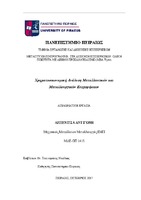Χρηματοοικονομική ανάλυση μεταλλευτικών και μεταλλουργικών επιχειρήσεων

View/
Keywords
Κατασκευαστικός κλάδος ; Επιχειρήσεις ; Ελληνική οικονομία ; Χρηματοοικονομικοί δείκτες ; Οικονομική κρίση ; Δείκτες μέτρησης της απόδοσηςAbstract
The goal of this dissertation, is to conduct an examination of the economic situation of
Greek construction companies, taking into account the ongoing Greek economic
recession. In order to conduct this analysis, secondary data were gathered from financial
reports of a sample of 11 Greek construction companies and it was processed
accordingly through the use of financial ratios. According to that, a discussion took
place in this research about the causes of the global crisis of 2008, as well as the Greek
crisis and the ways that the construction sector is interconnected with the wider economy
of a european nation.
The financial reports were gathered in annual intervals for the period from 2004 to 2015.
This was done so, in order to provide a more clear distinction about the effects of the
Greek economic recession which commenced around 2009-10. The categories of
financial ratios that were employed, measured the companies’ profitability, liquidity,
debt management, the cash conversion cycle, as well as other ratios important for the
construction sector.
Concerning the profitability ratios of the companies used for the present research, it was
notable that, on average, the returns of them declined between 2008 and 2009, while
after 2010 most of them sustained financial losses. Regarding their liquidity ratios, both
their current and quick ratios indicate that the sample companies can, on average, meet
with their obligations towards third parties, such as suppliers. However, the average
values of these ratios are marginally over the value of “1”, meaning that they generally
face difficulties, and if the adverse economic conditions continue, they might encounter
increased risk. Regarding the debt management ratios, it is shown that the debt/asset
ratios are increasing after 2010, while the values of Times-earned-interest ratio decrease.
This possibly indicates that the sample companies result in raising their debt for facing
economic issues. However, the declining profitability shows that they might have
problems in the future in regards to serving their interest obligations towards creditors,
increasing, thus, possible risks of bankruptcy. The Inventory Resident period and the
Receivables collection period ratios showed significant increasing trends after 2008,
indicating a possible decline in demand for the services/products of the construction
companies. The Days payable outstanding ratio, presents also increasing trends after
2008. However, these can be beneficial for the construction companies, as they
strengthen their liquidity, while also indicating their negotiating power with their
counterparties. The cash conversion cycle had an increasing trend up until 2013,
meaning that the companies required a larger period to gather cash from their clients,
with its values declining on 2014 and 2015. The examination of the fixed asset turnover
ratio, post 2010, showed that the companies in the sample do not use their assets for
generating sales in a very efficient manner. The same holds true for the working capital
turnover ratio, as it declines after 2011, meaning that the companies in the sample do not
use their working capital in a very efficient manner for generating sales.
Generally, the majority of the financial ratios examined show negative trends after 2009-
10, which could be reasonably attributed to the Greek economic crisis. Certain ratios
indicate a rise in the period 2014-15. However, one should consider that the examination
cannot capture in the full extent events that took place in 2015, such as the imposition of
capital controls in the Greek banks, as they are relatively recent. Further research should
take such events into account. It is also suggested that an econometric approach should
be used in order to establish causal relationships for the variables that affect ratios such as the profitability of a construction company, both in a micro and macro level, in order
to gain a better understanding of the sector’s dynamics.


